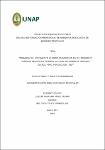Dinámica del crecimiento de árboles individuales del bosque de varillal seco en la Reserva Nacional Allpahuayo-Mishana, Iquitos, Perú. Periodo 2004-2017
Abstract
Se desarrolló dentro del proyecto de investigación de la UNAP denominado, “dinámica del
crecimiento, mortalidad, reclutamiento, diversidad, flujos (CO2e, H2o) y retroalimentación
dentro del ciclo de carbono y agua en un bosque tropical (Tello 2017, p 51), para evaluar un
ecosistema especial de la Amazonía, que según Mendoza (2007, p. 5), los “varillales” son
bosques que crecen sobre suelos de arena blanca con alta densidad de árboles y arbustos
por lo general son muy delgados y de baja estatura. Con el objetivo de determinar la
dinámica del crecimiento de árboles individuales del bosque de varillal seco en la reserva
nacional Allpahuayo-Mishana, Iquitos, Perú, se realizó un estudio bajo el principio del
inventario forestal continuo, durante el periodo 2004 al 2017, usando tres parcelas
permanentes de una hectárea cada una dividida en 100 sub parcelas de 10 x 10 m. El área
basal en el bosque varillal alto seco aumenta en función del tiempo registrándose un
promedio 16,82 m2/ha en el 2004, 19,35 en el 2007 y 27,09 m2/ha en el 2017. El volumen de
madera mantiene esta tendencia, 161,16 m3/ha en el 2005, 187,78 en el 2007 y 277,53
m3/ha en el 2017.
Entre el censo 2004 al 2017, los árboles con alta abundancia de individuos tuvo un
IMA=0,41 cm/año, los árboles con abundancia media un IMA=0,39 cm/año.
Las lianas restringieron el crecimiento de los árboles (IMA= 0,19 cm/año) y en los árboles sin
lianas fue 0,36 cm/año. La menor tasa anual de crecimiento (1,22%) corresponde a los
árboles con lianas que restringen su crecimiento y en los árboles sin lianas fue 1,94 %. La
tasa anual de crecimiento en los árboles con copa regular de la parcela 9 fue 2,35 %, los
árboles con copa irregular fue 2,39 %. It was developed within the UNAP research project called "growth dynamics, mortality,
recruitment, diversity, flows (CO2e, H2O) and feedback within the carbon and water cycle in
a tropical forest (Tello 2017, p.51), so as to evaluate a special ecosystem of the Amazon
that, according to Mendoza (2007, p.5), the "varillales" are forests that grow on white sand
soils with a high diversity of trees and shrubs that are usually very thin and short. In order to
determine the growth dynamics of individual trees of the high dry varillal forest in the
Allpahuayo - Mishana national reserve, Iquitos, Peru, a study was carried out under the
principle of continuous forest inventory, during the period from 2004 to 2017, using three
permanent plots of one hectare, each divided into 100 subplots of 10 x 10 m. The basal area
in the high dry varillal forest increases as a function of time, registering an average of 16.82
m2/ha in 2004, 19.35 in 2007 and 27.09 m2/ha in 2017. The volume of wood keeps this trend,
161.16 m2/ha in 2005, 187.78 in 2007 and 277.53 m2/ha in 2017.
Between the 2004 and 2017 census, trees with high abundance of individuals had an AAI =
0.41 cm/year, trees with an average abundance an AAI = 0.39 cm/year. Vines restricted the
growth of trees (AAI = 0.19 cm/year) and in trees without vines it was 0.36 cm/year. The
lowest annual growth rate (1.22%) corresponds to trees with vines that restrict their growth
and in trees without vines it was 1.94%. The annual rate of growth in trees with regular crown
from plot 9 was 2.35%, trees with irregular crown was 2.39%.
Collections
- Tesis [407]
The following license files are associated with this item:


